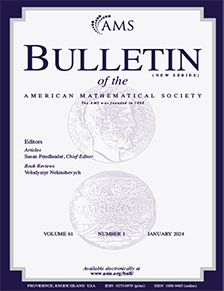Floer theory and low dimensional topology
HTML articles powered by AMS MathViewer
- by Dusa McDuff PDF
- Bull. Amer. Math. Soc. 43 (2006), 25-42 Request permission
Abstract:
The new $3$- and $4$-manifold invariants recently constructed by Ozsváth and Szabó are based on a Floer theory associated with Heegaard diagrams. The following notes try to give an accessible introduction to their work. In the first part we begin by outlining traditional Morse theory, using the Heegaard diagram of a $3$-manifold as an example. We then describe Witten’s approach to Morse theory and how this led to Floer theory. Finally, we discuss Lagrangian Floer homology. In the second part, we define the Heegaard Floer complexes, explaining how they arise as a special case of Lagrangian Floer theory. We then briefly describe some applications, in particular the new $4$-manifold invariant, which is conjecturally just the Seiberg–Witten invariant.References
- Raoul Bott, Morse theory indomitable, Inst. Hautes Études Sci. Publ. Math. 68 (1988), 99–114 (1989). MR 1001450, DOI 10.1007/BF02698544 Coh R. T. Cohen, Morse theory, graphs and string topology, GT/0411272.
- Charles Conley, Isolated invariant sets and the Morse index, CBMS Regional Conference Series in Mathematics, vol. 38, American Mathematical Society, Providence, R.I., 1978. MR 511133, DOI 10.1090/cbms/038 DGR N. Dunfield, S. Gotov and J. Rasmussen, The superpotential for knot homologies, GT/0505662. EFT E. Eftekhary, Filtration of Heegaard Floer homology and gluing formulas, GT/0410356.
- John B. Etnyre, On symplectic fillings, Algebr. Geom. Topol. 4 (2004), 73–80. MR 2023278, DOI 10.2140/agt.2004.4.73
- Yakov M. Eliashberg and William P. Thurston, Confoliations, University Lecture Series, vol. 13, American Mathematical Society, Providence, RI, 1998. MR 1483314, DOI 10.1090/ulect/013
- John B. Etnyre, On symplectic fillings, Algebr. Geom. Topol. 4 (2004), 73–80. MR 2023278, DOI 10.2140/agt.2004.4.73
- Andreas Floer, An instanton-invariant for $3$-manifolds, Comm. Math. Phys. 118 (1988), no. 2, 215–240. MR 956166, DOI 10.1007/BF01218578
- Andreas Floer, Morse theory for Lagrangian intersections, J. Differential Geom. 28 (1988), no. 3, 513–547. MR 965228
- Andreas Floer, Symplectic fixed points and holomorphic spheres, Comm. Math. Phys. 120 (1989), no. 4, 575–611. MR 987770, DOI 10.1007/BF01260388
- David Gabai, Foliations and the topology of $3$-manifolds. II, J. Differential Geom. 26 (1987), no. 3, 461–478. MR 910017
- Emmanuel Giroux, Géométrie de contact: de la dimension trois vers les dimensions supérieures, Proceedings of the International Congress of Mathematicians, Vol. II (Beijing, 2002) Higher Ed. Press, Beijing, 2002, pp. 405–414 (French, with French summary). MR 1957051 GRO M. Gromov, Pseudo holomorphic curves in symplectic manifolds, Inventiones Mathematicae 82 (1985), 307–47.
- Michael Hutchings and Yi-Jen Lee, Circle-valued Morse theory and Reidemeister torsion, Geom. Topol. 3 (1999), 369–396. MR 1716272, DOI 10.2140/gt.1999.3.369
- Mikhail Khovanov, A categorification of the Jones polynomial, Duke Math. J. 101 (2000), no. 3, 359–426. MR 1740682, DOI 10.1215/S0012-7094-00-10131-7 Lee Yi-Jen Lee, Heegaard splittings and Seiberg–Witten monopoles, GT/0409536. LIVN C. Livingston and S. Naik, Ozsváth–Szabó and Rasmussen invariants of doubled knots, GT/0505361. MAN C. Manolescu, Nilpotent slices, Hilbert schemes and the Jones polynomial, SG/0411015.
- J. Milnor, Morse theory, Annals of Mathematics Studies, No. 51, Princeton University Press, Princeton, N.J., 1963. Based on lecture notes by M. Spivak and R. Wells. MR 0163331, DOI 10.1515/9781400881802 NEM A. Némethi, On the Heegaard Floer homology of $S^3_{-p/q}(K)$, GT/0410570.
- S. P. Novikov, Multivalued functions and functionals. An analogue of the Morse theory, Dokl. Akad. Nauk SSSR 260 (1981), no. 1, 31–35 (Russian). MR 630459 OSTR B. Owens and S. Strle, Rational homology spheres and four-ball genus, GT/0308073.
- Peter Ozsváth and Zoltán Szabó, Holomorphic disks and topological invariants for closed three-manifolds, Ann. of Math. (2) 159 (2004), no. 3, 1027–1158. MR 2113019, DOI 10.4007/annals.2004.159.1027
- Peter Ozsváth and Zoltán Szabó, Holomorphic triangle invariants and the topology of symplectic four-manifolds, Duke Math. J. 121 (2004), no. 1, 1–34. MR 2031164, DOI 10.1215/S0012-7094-04-12111-6
- Peter Ozsváth and Zoltán Szabó, Holomorphic disks and knot invariants, Adv. Math. 186 (2004), no. 1, 58–116. MR 2065507, DOI 10.1016/j.aim.2003.05.001 OS2 P. Ozsváth and Z. Szabó, Knots with unknotting number one and Heegaard Floer homology, GT/0401426.
- Peter Ozsváth and Zoltán Szabó, Heegaard diagrams and holomorphic disks, Different faces of geometry, Int. Math. Ser. (N. Y.), vol. 3, Kluwer/Plenum, New York, 2004, pp. 301–348. MR 2102999, DOI 10.1007/0-306-48658-X_{7} PLAM O. Plamenevskaya, Transverse knots and Khovanov homology, GT/0412184. RASM1 J.A. Rasmussen, Khovanov homology and the slice genus, GT/0402131. RUST R. Rustamov, On Plumbed $L$-spaces, GT/0505349. Sei P. Seidel, Fukaya categories and deformations, SG/0206155. SSM P. Seidel and I. Smith, A link invariant from the symplectic geometry of nilpotent slices, SG/0405089.
- Clifford Henry Taubes, The Seiberg-Witten invariants and symplectic forms, Math. Res. Lett. 1 (1994), no. 6, 809–822. MR 1306023, DOI 10.4310/MRL.1994.v1.n6.a15
- Edward Witten, Supersymmetry and Morse theory, J. Differential Geometry 17 (1982), no. 4, 661–692 (1983). MR 683171
Additional Information
- Dusa McDuff
- Affiliation: Department of Mathematics, Stony Brook University, Stony Brook, New York 11794-3651
- MR Author ID: 190631
- Email: dusa@math.sunysb.edu
- Received by editor(s): November 30, 2004
- Received by editor(s) in revised form: June 1, 2005
- Published electronically: October 6, 2005
- Additional Notes: This article is based on a lecture presented January 7, 2005, at the AMS Special Session on Current Events, Joint Mathematics Meetings, Atlanta, GA. The author was partly supported by NSF grant no. DMS 0305939.
- © Copyright 2005
American Mathematical Society
The copyright for this article reverts to public domain 28 years after publication. - Journal: Bull. Amer. Math. Soc. 43 (2006), 25-42
- MSC (2000): Primary 57R57, 57M27, 53D40, 14J80
- DOI: https://doi.org/10.1090/S0273-0979-05-01080-3
- MathSciNet review: 2188174


